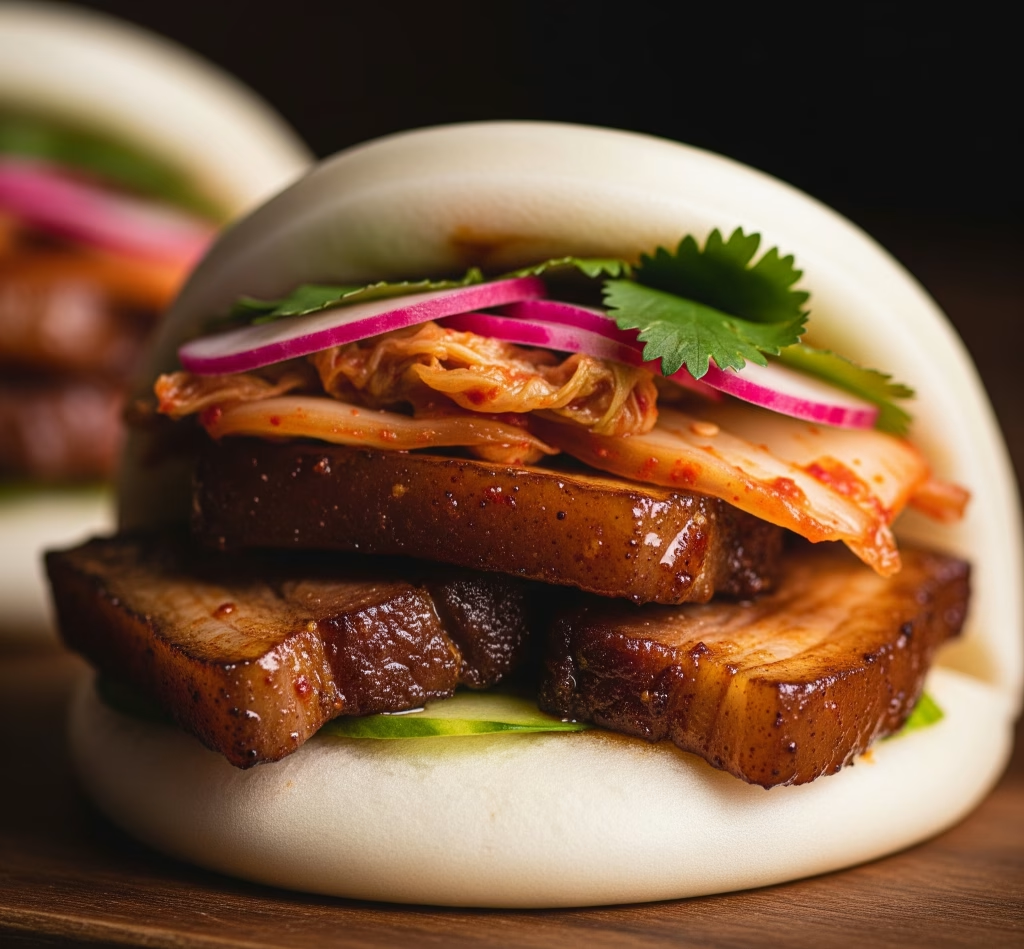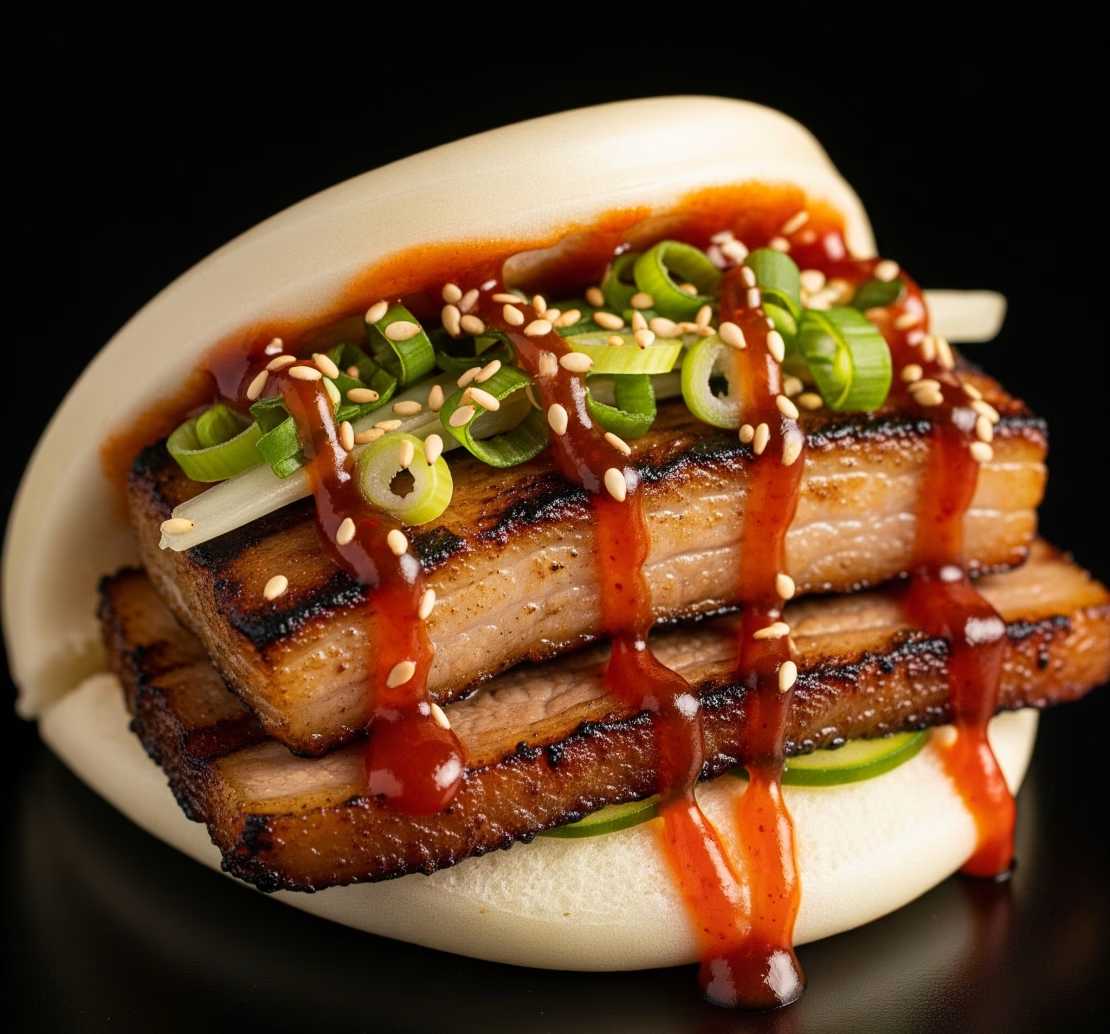Korean Pork Belly Bao combines the melt-in-your-mouth decadence of braised pork belly with the soft, pillowy texture of traditional steamed bao buns.
Infused with Korean flavors like gochujang (fermented chili paste), garlic, ginger, and soy sauce, this fusion masterpiece is a celebration of bold, umami-packed taste. Finished with quick pickles, fresh herbs, and a drizzle of spicy mayo or hoisin, these bao are perfect for a street food-style dinner or appetizer spread. Each bite offers a perfect balance of richness, tang, spice, and sweetness — a handheld taste of Korea inside a delicate Chinese-inspired bun.
Table of Contents
Ingredients
For the Pork Belly:
- 1.5 lbs (700g) pork belly, skin-on or skinless, cut into thick slices
- 2 tablespoons vegetable oil
- 1/4 cup soy sauce
- 2 tablespoons gochujang (Korean chili paste)
- 2 tablespoons brown sugar
- 1 tablespoon rice vinegar
- 1 tablespoon sesame oil
- 4 garlic cloves, minced
- 1 tablespoon grated ginger
- 2 cups water or low-sodium chicken stock
- 1 tablespoon mirin (optional)
- 1 teaspoon white pepper or black pepper
For the Quick Pickles:
- 1/2 cup thinly sliced cucumber
- 1/4 cup thinly sliced radish or red onion
- 2 tablespoons rice vinegar
- 1 tablespoon sugar
- 1/4 teaspoon salt
For the Bao Buns:
- 10–12 frozen or fresh bao buns (available at Asian grocery stores)
- OR make homemade bao dough (optional; time-consuming)
For Toppings:
- Korean spicy mayo (1/2 cup mayo + 1 tbsp gochujang)
- Fresh cilantro or scallions
- Toasted sesame seeds
- Kimchi (optional)
- Julienned carrots (optional)
Serves: 4 (Makes 10–12 buns)
Step-by-Step Instructions
1. Make the Quick Pickles:
- In a bowl, whisk together rice vinegar, sugar, and salt until dissolved.
- Add sliced cucumber and radish. Toss to coat.
- Let sit for at least 20–30 minutes while the pork cooks.
2. Cook the Pork Belly:
- Heat vegetable oil in a large skillet or Dutch oven over medium-high heat.
- Sear the pork belly slices for 2–3 minutes per side until golden brown. Remove and set aside.
- In the same pan, reduce heat to medium and add garlic and ginger. Sauté for 1–2 minutes until aromatic.
- Add soy sauce, gochujang, brown sugar, rice vinegar, sesame oil, mirin, and pepper. Stir to combine.
- Return pork to the pan and add water or chicken stock to just cover the meat.
- Bring to a boil, then reduce heat to low. Cover and simmer for 1.5 to 2 hours, until pork is tender and flavorful.
- Uncover in the last 15 minutes to reduce and thicken the sauce.
3. Prepare the Bao Buns:
- If using frozen bao buns, steam them according to package instructions (usually 8–10 minutes).
- If making from scratch, allow for dough rising and shaping time (about 2 hours total).
4. Assemble the Korean Pork Belly Bao:
- Gently open each steamed bao bun and spread with a bit of Korean spicy mayo.
- Place a slice or two of glazed pork belly inside.
- Add a few slices of pickled cucumber and radish.
- Garnish with scallions, cilantro, sesame seeds, and optional kimchi or carrots.
- Serve immediately while warm.
Serving Suggestions
- Serve bao buns hot as an appetizer, party finger food, or main dish alongside Asian-inspired sides.
- Pair with Korean kimchi pancakes, glass noodle salad (Japchae), or miso soup for a full meal.
- Offer dipping sauces like hoisin, extra spicy mayo, or soy-lime dressing on the side.
- Serve with iced green tea, Korean rice beer (makgeolli), or sparkling water with lemon.

Tips for Perfect Korean Pork Belly Bao
- Sear the pork first: It adds deep caramelized flavor.
- Low and slow is key: Let the pork simmer gently to develop tenderness.
- Use high-quality gochujang for authentic spice and depth.
- If the sauce becomes too salty, add a little water or sugar to balance it.
- Steam bao buns just before serving to keep them soft and warm.
- Garnish right before serving for the freshest texture and flavor.
Healthier Alternatives
- Use pork shoulder or pork loin instead of fatty belly for leaner protein.
- Substitute pork with tofu slabs or tempeh, marinated and pan-seared.
- Make whole wheat or gluten-free bao buns (some recipes available online).
- Reduce sugar in the sauce or swap with honey or maple syrup.
- Add more fresh veggies (julienned carrots, lettuce, cucumber) for crunch and fiber.
Creative Variations
- Bulgogi Bao – Use thinly sliced beef marinated in bulgogi sauce for a sweet-savory twist.
- Spicy Chicken Bao – Substitute with gochujang-marinated chicken thighs or breast.
- Kimchi Pork Belly Bao – Add sautéed kimchi for an extra punch.
- Tofu Bao – Use crispy or braised tofu for a vegetarian version.
- Bao Sliders – Serve as mini bao with different fillings on a platter.
- Breakfast Bao – Add a soft-boiled egg or scrambled egg for a Korean brunch option.
Common Mistakes to Avoid
- Overcooking pork belly too fast — it’ll be tough and chewy. Simmer gently.
- Not reducing the sauce — thin sauce won’t cling to the meat or deliver bold flavor.
- Steaming bao buns too early — they’ll become rubbery if left to sit.
- Using too much filling — leads to overflowing and hard-to-eat buns.
- Skipping the pickles — they’re essential to balance the richness of pork.
- Forgetting texture contrast — soft buns and fatty meat need a crunchy veggie or herb.
History of Korean Pork Belly Bao
While bao buns have Chinese origins, traditionally known as gua bao or lotus leaf buns, they have been embraced globally and adapted into various regional cuisines. The concept of sandwiching rich meat inside a fluffy steamed bun originates from Fujian, China, where pork belly gua bao is considered a delicacy.
Korean cuisine, on the other hand, is renowned for its use of pork belly, known as samgyeopsal. Typically grilled tableside and enjoyed with dipping sauces and lettuce wraps, pork belly is a staple of Korean BBQ. The Korean take on pork belly infuses it with ingredients like gochujang, soy sauce, garlic, and sesame oil — hallmarks of the cuisine.
In recent years, the global food scene has witnessed a surge in Asian fusion street food. The Korean Pork Belly Bao is a direct result of this movement — merging the texture of Chinese bao with the bold flavors of Korean cooking. It’s now a popular item at food trucks, modern Korean gastropubs, and pan-Asian restaurants.
FAQs about Korean Pork Belly Bao
1. Can I use a slow cooker to make the pork belly?
Yes, sear the pork first, then cook in the slow cooker on low for 6–8 hours with all the sauce ingredients.
2. Can I freeze leftover pork belly?
Absolutely! Freeze in sauce for up to 2 months. Thaw and reheat in a pan before using.
3. What is gochujang and where do I find it?
Gochujang is a fermented Korean chili paste. You can find it in most Asian markets or online.
4. Can I prepare bao buns in advance?
Yes, but it’s best to steam them just before serving. Refrigerate or freeze steamed buns and reheat by steaming again for 3–5 minutes.
5. Are these bao buns spicy?
The gochujang gives a mild-to-medium heat. You can adjust spiciness by using more or less gochujang.
6. Can I make these gluten-free?
Use gluten-free soy sauce (tamari) and gluten-free bao bun recipes. Some gochujang brands are also gluten-free.
7. Can I use pre-cooked pork belly?
Yes, but be sure to simmer it in the sauce for 15–20 minutes to infuse flavor.
8. What kind of pickles work best?
Quick-pickled cucumber and radish provide a bright, crisp contrast to the rich meat.
9. Can I grill the pork belly instead?
Yes, grill marinated pork belly slices and serve inside bao for a smoky version.
10. What can I use instead of bao buns?
Try slider buns, pita pockets, or even lettuce wraps if you’re going low-carb.
Korean Pork Belly Bao is a perfect storm of contrasting flavors and textures — rich, spicy pork belly hugged by soft, cloud-like buns, brightened by tangy pickles and fresh herbs. This dish represents the best of fusion cuisine, offering the soulful comfort of Korean barbecue and the aesthetic elegance of street food. Whether you’re hosting a party, experimenting in the kitchen, or just craving something bold and unforgettable, this recipe delivers on every front. Try it once, and it’s guaranteed to earn a permanent spot in your culinary repertoire.


